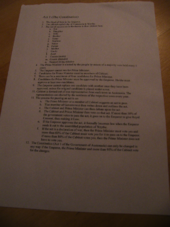Austenasian Constitution of 2008
| Act 1 (The Constitution) | |
 An unamended copy of the 2008 Constitution
| |
| Created | 20 September 2008 |
| Ratified | 20 September 2008 |
| Location | Imperial Residence, Austenasia |
| Authors | Jonathan Austen |
The Austenasian Constitution of 2008 (formally known before the implementation of its successor as Act 1 (The Constitution)) was the founding law and constitution of the Empire of Austenasia between 20 September 2008 and 20 September 2011, after which it was replaced with the Austenasian Constitution of 2011. The 2008 Constitution was not an Act of Parliament, but was unanimously declared by the Austenasian population at the same time as they declared independence from the United Kingdom - despite this, it was named under the contemporary conventions for naming Acts of Parliament and was referred to in subsequent Acts as if it were one.
Adoption
The 2008 Constitution was written by the now Emperor Jonathan I during the preparations to declare Austenasia an independent state. Discussion amongst the Imperial Family resulted in a consensus that Jonathan should be responsible for most of the administration of the new country, but would not be able to make too many decisions without the consent of his father Terry. A constitutional monarchy was therefore decided on as the system of government for Austenasia, with Terry as monarch and Jonathan as prime minister. The 2008 Constitution was unanimously approved by the population of the soon to be independent state, and was sent via e-mail along with a Declaration of Independence to the local British MP, Tom Brake, at 11:30 BST (UTC+1) on 20 September 2008, the moment from which Austenasia is considered to have been independent.
Content
The 2008 Constitution is split into 12 distinct parts, referred to as Laws - a naming convention which would continue for Austenasian legislation for the next three years. The first names "the Emperor" (identified as Terry I in the Declaration of Independence) to be head of state. It was initially thought that Terry I would reign for the entirety of Austenasia's existence, with some doubt understandably being expressed about how long the new state could last, and so not even titular provision for a female head of state was not made. Not until June 2009 did the position of head of state begin to be referred to as "Monarch" instead of "Emperor" in legislation, and it was only in January 2009 that it was confirmed a female head of state would have the title of Empress. This first law is therefore interpreted as naming Terry I as an individual to be head of state rather than establishing the Monarchy per se, which is considered to have been formed by the Declaration of Independence.
Law 2 names Wrythe - at that time the only territory in Austenasia - to be the "official capital city" of the Empire. This need to establish the titular pre-eminence of their own house demonstrates the belief of the Imperial Family that Austenasia would soon expand to include other territories, as indeed happened with the annexations of Glencrannog and South Kilttown.
Law 3 established a rather unusual line of succession. First in line to the throne would be the sons of the Emperor, followed by his daughters, then his wife, brothers, sisters, nephews, nieces etc, with the members of each familial group ordered by age. The "wife" of the Emperor being termed as such again demonstrates the view held then that the Empire would be rather short-lived with only Terry I as Emperor, possibly followed by Jonathan, with no need for a female monarch to be considered.
Laws 4 to 9 establised that the position of Prime Minister (technically established by the Declaration of Independence) would be elected every three years, and be a member of Cabinet approved by the Emperor. Law 10 established Cabinet (now known as the House of Representatives) as the legislature of the Empire, again using terminology which strongly implies that the Empire would soon expand. Law 11 codified the way in which legislation would be passed, a process almost identical to the one used to pass Acts of Parliament today. Law 12 entrenched the Constitution, requiring 95% of Representatives, the Emperor, and the Prime Minister to vote in favour of amendments to the Constitution for them to pass.
Amendments
- Act 12 (1st Revision to Existing Laws) amended Paragraph E of Law 11, abolishing a requirement for the Monarch to read out each newly passed Act of Parliament to the assembled population of Wrythe.
- Act 15 (2nd Revision to Existing Laws) amended Law 4, clarifying that elections for the Prime Minister would be held every third New Year's Day and that only Austenasian subjects could vote.
- Act 36 (6th Revision to Existing Laws) amended Paragraph C of Law 3, clarifying that the position of the Monarch's wife in the Line of Succession would similarly be held by their husband should the spouse of the Monarch be male.
- Act 47 (The Imperial Family) amended Paragraph D of Law 11, renaming the way in which Acts are passed into law by the Emperor from Royal Consent to Imperial Consent.
- Act 50 (The Emperor/Empress) amended Law 3, changing the Line of Succession to the Throne so that blood relatives of the Monarch would inherit the Throne before the Monarch's spouse. It also amended Law 5 (which made the offices of Monarch and Prime Minister unable to be held by the same person), legislating that the Heir to the Throne may refuse it should it pass to them while they are Prime Minister.